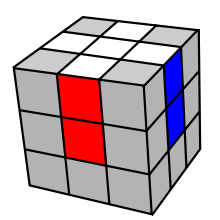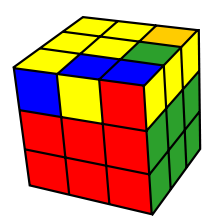- Fridrich Method
-
The CFOP (Cross - F2L - OLL - PLL) system, simply known as the Fridrich Method is one of the most commonly used methods in speedsolving a Rubik's Cube. This method was first developed in the early 1980s by Jessica Fridrich, and was published online in 1997.[1]
The method works on a layer-by-layer system, first "solving" a cross on the bottom, continuing to solve the first two layers (F2L), orienting the last layer (OLL), and finally permuting the last layer (PLL).
Contents
The method
The method consists of 4 steps:
- The Cross - This first stage involves solving four edge pieces on one side. By convention, the side most widely used by speedcubers is white. This step is the most intuitive step of the solve but it is also very fast; Experienced speedcubers can solve it in about 2–3 seconds, and in all cases it requires 8 or fewer turns to solve.
- Solve the First Two Layers (F2L) - This stage consumes most of the time as it has the most turns to solve. In most beginner methods, the corners of the cube and edge pieces are solved separately. In F2L, both the corner piece and edge pieces are solved at the same time, reducing the number of twists needed. There are 42 different cases for F2L, 41 plus the already solved case. However, many speedcubers solve this step intuitively.
- Orientation of Last Layer (OLL) - This stage involves manipulating the top layer so that all 9 cubes on the top side are the same color, even at the expense of incorrect colors on other sides. This stage involves learning a total of 57 algorithms.
- Permutation of Last Layer (PLL) - The final stage involves moving the pieces of the top layer while preserving their orientation. There are a total of 21 algorithms for this stage.
Tournament use
The Fridrich Method is used by many speedcubers, for example Rowe Hessler, Feliks Zemdegs and Erik Akkersdijk. The Fridrich Method is commonly preferred for speedcubing because it relies heavily on algorithms as opposed to more intuitive methods such as Roux or Petrus. By not being intuitive it makes the solver rely only on pattern recognition and muscle memory. The majority of top speed cubers on the WCA ranking list are Fridrich solvers.[2]
External links
- Jessica Fridrich's official site
- Description of the Fridrich Method
- Cubewhiz List of OLL and PLL algorithms
- Cubezone List of OLL and PLL algorithms
- Joel's List of OLL and PLL algorithms
References
- ^ Shotaro "Macky" Makisumi. "Speedcubing". cubefreak.net. Archived from the original on 2007-07-03. http://web.archive.org/web/20070703151003/http://www.cubefreak.net/speedcubing.html. Retrieved 2007-08-31.
- ^ http://www.worldcubeassociation.org/results/events.php
Rubik's Cube Inventor Rubik's Cubes Cubic variations Helicopter Cube · Skewb · Square 1 · Sudoku Cube · Void Cube
Non-cubic variations TetrahedralOctahedralDodecahedralIcosahedralHigher-dimensional
virtual variationsDerivatives Missing Link · Rubik's 360 · Rubik's Clock · Rubik's Magic · Rubik's Magic: Master Edition · Rubik's Revolution · Rubik's Snake · Rubik's Triamid
World record holders Erik Akkersdijk · Muhammad Iril Khairul Anam · Dan Cohen · Rowe Hessler · Yu Nakajima · Feliks Zemdegs
Renowned solvers Jessica Fridrich · Chris Hardwick · Leyan Lo · Shotaro "Macky" Makisumi · Toby Mao · Tyson Mao · Frank Morris · Lars Petrus · David Singmaster · Ron van Bruchem
Solutions Mathematics Official organization 
This puzzle/logic game-related article is a stub. You can help Wikipedia by expanding it.



